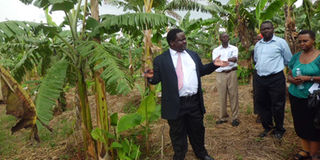Controlling banana viruses on farm

Dr Imelda Kashaija (R) and her team from Naro are encouraging farmers to observe best practices. Photo by Lominda Afedraru
What you need to know:
Disease spread between plants on the farm is mainly through infections from contaminated tools and infected suckers, which start as wilting of leaves that eventually dry, and by insect pollinators, writes Lominda Afedraru.
Following an outbreak of deadly banana diseases, farmers have been urged to be vigilant.
Bananas across Africa are reported to be infected with the ‘streak virus’ and banana bacterial wilt (BBW) which can destroy entire plantations. Scientists are considering using powerful gene-editing tool CRISPR to make the fruit immune to a virus. The tips below can help you control the viruses which have no treatment.
Symptoms
• Yellow bacterial ooze from plant organs.
• Internal discolouration of the fruit at all stages.
• Premature ripening of the fruits.
• Internal yellow discolouration
of vascular bundles when the stem is cut.
• Wilting and yellowing of leaves and bracts.
• Shriveling of male buds.
• Rotting of the fruits and brown
stains making affected fruits inedible.
• Farmers need to watch their crop near flowering since banana cultivars become most vulnerable to BXW infection at this stage.
Transmission
• Planting of infected plant materials.
• Use of contaminated tools.
• Contaminated soil (the bacteria can stay in the soil for up to three months even without a host).
• By vectors through exposed male flowers and insects (bees, fruit flies and grass flies) during pollination.
• Irrigation water, nectar sucking birds and bats.
• Movement of banana materials for planting or replanting and through the roots especially if injured.
• The mode of spread can be grouped into three:
i) Within the farm/plantation.
ii) Through introduction into new areas.
iii) Through vectors and animals.
Disease spread between plants on the farm is mainly through infections from contaminated tools and infected suckers, which start as wilting of leaves that eventually dry, and by insect pollinators.
Insect transmitted infections lead to wilting and rotting of the banana male bud, pre-mature ripening and rotting of fingers that become unpalatable. For introduction into new areas, regions or countries, the main mode of long-distance spread is banana trade (fruits, leaves and planting material). This is the main mode of transmission from Uganda into western Kenya and other banana importing counties. Farmers need to note that infected plants die within two weeks.

Agriculture hygiene is the best way to combat banana viruses such as the banana wilt. Courtesy photo
Yield losses
Yield losses of 10 to 100 per cent have been reported depending on cultivar susceptibility, stage of growth of the plant and the prevailing climatic conditions.
Disease management
Remove infected crops to reduce spread of the disease by uprooting the whole plant and burying it.
De-budding (removal of male flowers).
Disinfecting tools before use by sterilising them using sodium hypochlorite (household bleach) or heating them.
Monitoring of the disease
• Provide good drainage on the farm.
• Use of healthy and disease-free suckers during planting.
• Tissue culture plantlets can be used to produce disease- free planting materials.
• Leave the field fallow for some time before replanting in case of disease outbreak.
Replanting
Farmers need to note that the most important way is to prevent spread and eliminate the pathogen early since BXW reduction depends on two key actions namely prompt removal of sources of inoculums and reducing and eliminating opportunities for spread. The disease must be monitored so that it does not spread to other regions. Farmers can potentially spread the disease through contaminated tools.
Ferrying of planting materials should also be discouraged.
About viruses A disease known as Banana Xanthomonas Wilt (BXW) or Banana Bacterial Wilt (BBW) is ravaging the crop in different parts of the country. The disease that affects banana cultivars causes up to 100 per cent losses. The bacterium is known as Xanthomonas campestris pv musacearum.In Uganda the disease attacked many banana cultivars in 2001 in Masaka, Lwengo, Luweero and several districts in western. Since then, it has been spreading. “Practicing agricultural hygiene is the best way to prevent the viruses. Uproot the diseased crop and burn,” says Michael J Ssali a farmer.




